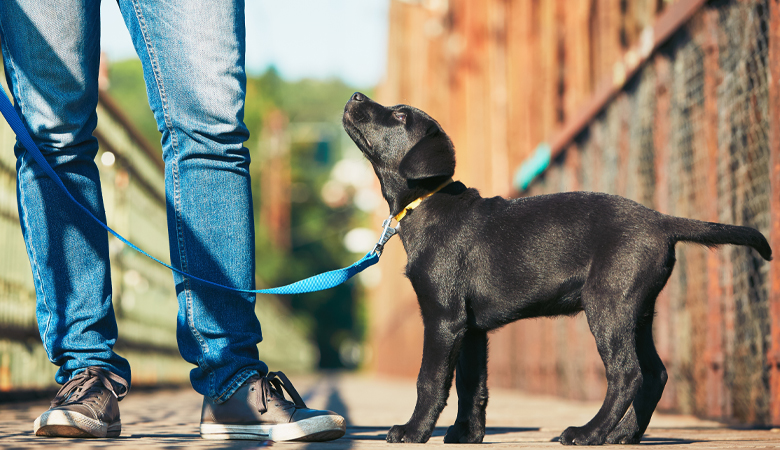How to train your pup to walk on a leash
Written by |
If your puppy is used to your family at home, it is also important that he will learn things. An important part is learning how to walk your pup on a dog leash or dog harness. If you do this correctly, you will make it easier and more fun for yourself to walk your dog in the future.

Getting used to the environment
Start off with a collar or harness that fits your pup and give your puppy enough time to get used to it. Secure it firmly enough, so that the pup cannot pull it over its head. For example, choose a strong nylon collar, which is easy to adjust but has sufficient control, like the EzyDog Checkmate Collar or a leather collar like the Ruffwear Timberline (Frisco) Collar or . Regularly check how tight the collar is, because your puppy is of course growing and the collar should not be too tight. A collar is comfortable when you can put two fingers between your dog and the collar.
The leash
After the collar comes the lead. Preferably use a short, sturdy leash and no flex line, for example the Halti Training Lead or EzyDog Vario 4 Lead. A flex line is always somewhat tense and teaches your pup that he may/should pull on the leash.
Getting used to the dog leash
Many puppies find it strange that there is a leash attached to the collar. Let them get used to this, for example by attaching the leash in the house and letting the pup walk around with the leash attached to the collar. Pups are often inclined to sit down or pull back on the leash. Go to a quiet place, not too close to home. It may otherwise be that your pup only wants to go back to the safety of home. The world is already new and exciting enough.
Pulling on the leash
Do not pull on the leash yourself. This often makes your pup pull back: your pup wants to go in the other direction. Attract your pup with treats or a high pitch voice to come next to you and reward your pup if he comes without the leash being tense. Always walk small bits and reward your pup if he walks with a relaxed leash. Give your pup time to sit down occasionally and to get used to the new situation. Start with a few minutes and expand this weekly. Do you have an adult dog that pulls on the leash, then read our other article my dog pulls on the leash.
Do not attempt to encourage pulling behaviour. This is easier said than done. Subconsciously, many people reward pulling on the leash, for example by pulling the dog to come or to let it play with the lead itself.
When your pup pulls on the leash, stand still for a moment and walk in the other direction. Reward your pup when he walks with a loose leash next to you. Should you pass other dogs, let your pup sit and relax for a moment. This way you do not reward pulling and your pup will learn to walk along nicely.
Finally…
A number of things are important for teaching your pup to walk on the leash:
- A quality collar
- A proper lead
- Do not reward pulling behaviour
It often requires a lot of patience and perseverance from you as the owner. However, if you persevere now and are consistent in avoiding pulling behaviour, you will have no issues walking your dog in the future. Good luck!
View our range of care products for your pup online.



